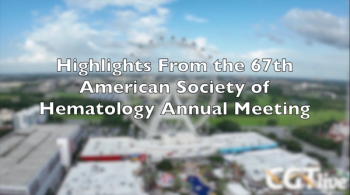
Patients With Spinal Muscular Atrophy Who Required Tracheostomies Show Motor Function Improvements in Real World Setting After Treatment With Zolgensma
The real-world data, which includes patients who received Zolgensma before and after tracheostomy, comes from the noninterventional RESTORE registry (NCT04174157).
Patients with spinal muscular atrophy (SMA) who also required tracheostomies and were treated with disease-modifying treatments (DMTs) including onasemnogene abeparvovec (Zolgensma; Novartis), a marketed adeno-associated virus vector (AAV)-based gene therapy, showed improvements in motor function, in addition to safety outcomes consistent with Zolgensma’s known safety profile. These real-world data, which come from the noninterventional RESTORE registry (NCT04174157), were presented in a poster at the
Among the 519 patients with SMA that had been enrolled in RESTORE by the May 2023 data cut-off, 31 patients that were treated with
Available data on efficacy outcomes for the 31 patients varied heavily, with many patients having been tested with different assessments. For the 18 patients who had available motor milestone data based on any assessment, 16 patients (88.9%) achieved or maintained motor milestones during the observation period. Clinically meaningful score improvements were seen in 13 of 17 patients (76.5%) who had Children’s Hospital of Philadelphia Infant Test of Neuromuscular Disorders (CHOP INTEND) scores. The change in CHOP INTEND score per month ranged from –1.0 to 4.0 (median, 0.43). Among the 4 patients who had Hammersmith Functional Motor Scale – Expanded scores available, 1 patient showed clinically meaningful improvement and 2 patients showed maintenance of their score. One of the 31 patients had a Hammersmith Infant Neurological Examination — Part 2 score and showed a clinically meaningful improvement in score.
In terms of safety, 23 (74.1%) of the 31 patients experienced treatment-emergent adverse events (TEAEs) and 22 (70.9%) of the 31 patients experienced TEAEs that were grade 3 or higher. Fourteen TEAEs of any grade were considered related to Zolgensma. There were 19 serious TEAEs in total and 4 of these (12.9%) were considered related to Zolgensma. Two of the 31 patients died, with 1 death attributed to respiratory failure and 1 death attributed to respiratory failure after removal of the tracheostomy. Neither of the 2 deaths were considered related to Zolgensma. TEAEs of special interest included hepatotoxicity (8 patients, 25.8%), transient thrombocytopenia (12 patients, 38.7%), cardiac AEs (9 patients, 29%), and thrombotic microangiopathy (1 patient, 3.2%).
Of the 31 patients with tracheostomies, most were from the United States (67.7%) and the vast majority had 2 SMN2 gene copies (96.8%). The group included 4 patients whose disease was identified by newborn screening and 27 patients who received a clinical diagnosis. The ages of the patients at diagnosis ranged from 0 to 14.0 months (median, 4.0); the ages of the patients at initial treatmentfor SMA ranged from 1.0 to 21.0 months (median, 5.0); and the ages of the patients at tracheostomy ranged from 2.2 to 28.3 months (median, 8.1). The group included 18 boys (58.1%) and 13 girls (41.9%). In addition to the US patients, 3 patients from Greece and 7 patients from Japan were included. Twenty-nine of the 31 patients (93.5%) had SMA type 1, 1 patient (3.2%) had SMA type 0, and 1 patient’s SMA type was not known (3.2%). The duration of follow-up from the first treatment to the last known follow-up ranged from 1.0 to 8.0 months (median, 6.0). First author Laurent Servais MD, PhD, a professor of paediatric neuromuscular Disease at the University of Oxford, and colleagues noted that data on the reasons for tracheostomy use and changes in ventilatory support after treatment with Zolgensma were not collected in RESTORE.
“In this analysis of the RESTORE registry, improvements in motor function after Zolgensma treatment were observed for patients who received tracheostomies in the real-world settings,” Servais and colleagues concluded. “Clinically meaningful motor function improvements were observed independent of DMT types received before or after Zolgensma administration and most patients were still alive at the end of follow-up in this analysis. TEAEs were consistent with the established safety profile of Zolgensma suggesting that, unlike previously reported, a greater risk of TEAEs was not observed in this small sample of patients with tracheostomies. Cumulatively, these data support the DMT administration can provide improvements in motor function for patients with SMA who received tracheostomies.”
REFERENCES
1. Finkel R, Matthews K, Lakhotia A, et al. Real-world outcomes following onasemnogene abeparvovec in patients with SMA and one SMN2 gene copy: findings from the RESTORE registry. Presented at: 2024 MDA Clinical and Scientific Conference; March 3-6; Orlando, FL. Poster #S102
Newsletter
Stay at the forefront of cutting-edge science with CGT—your direct line to expert insights, breakthrough data, and real-time coverage of the latest advancements in cell and gene therapy.































